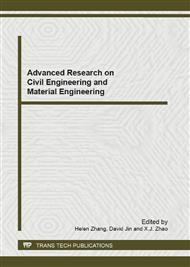p.368
p.372
p.376
p.380
p.384
p.388
p.392
p.396
p.400
Influence of Molecular Structure on Properties of Polycarboxylate Superplasticizers
Abstract:
The properties of polycarboxylate superplasticizers(PCs) are related to their structures. For better understanding the different properties between PCs, their structures should be examined. In this paper, three kinds of PCs are synthesized by radical copolymerization method. The structure and property of PCs are studied by means of high performance liquid chromatography, zeta potential, water reducing rate and fluidity of cement paste. The results show that the conversion rate of reaction monomers is over 97%, and the reaction monomers are fully in the polymerization. The ester-type PCs has a higher water reduction capacity than the ether-type. At the same dosage, the adsorption and dispersion ability of ester-type PCs are stronger than that of ether-type PCs, yet the ether-type PCs has better slump retention performance in the cement pastes.
Info:
Periodical:
Pages:
388-391
Citation:
Online since:
September 2012
Authors:
Price:
Сopyright:
© 2012 Trans Tech Publications Ltd. All Rights Reserved
Share:
Citation:


